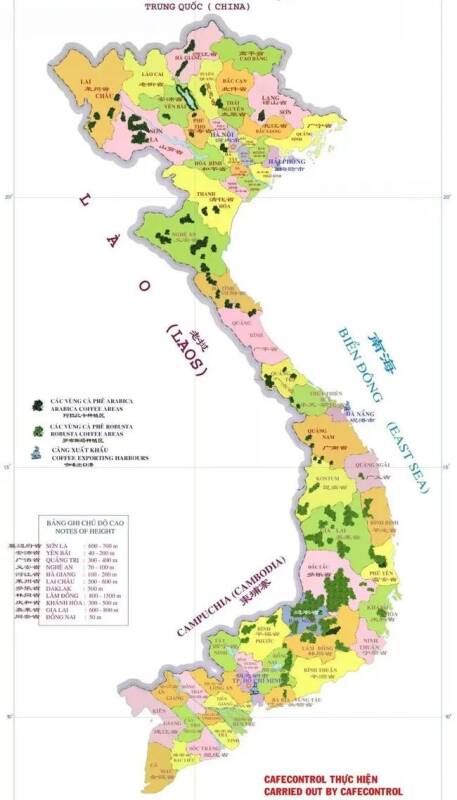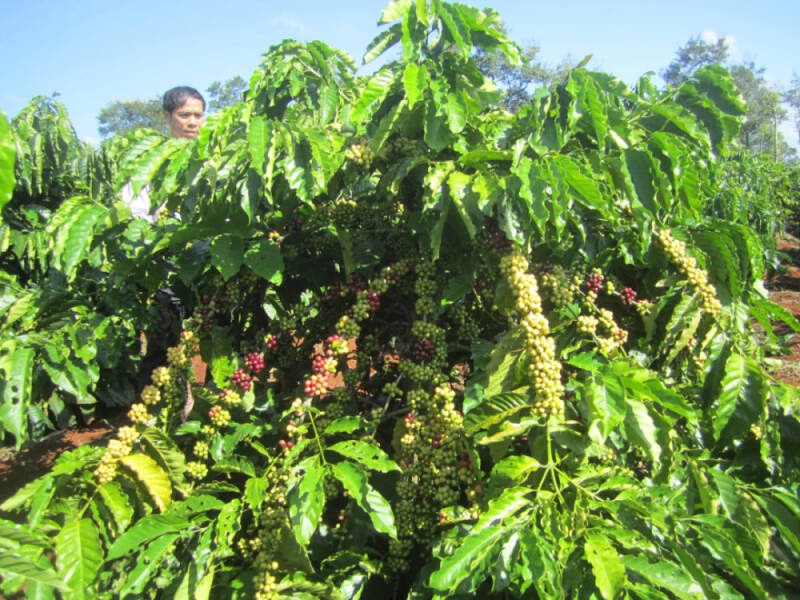Introduction to the development history of Vietnamese coffee, Vietnamese coffee producing areas, Vietnamese coffee bean varieties and classical Italian blending.
Vietnam is located at the southeast end of Indo-China Peninsula in Southeast Asia, bordering China, Laos and Cambodia, and bordering the South China Sea to the southeast. The topography of Vietnam is narrow and long, slightly S-shaped. The topography is high in the northwest and low in the southeast, and the territory is composed of mountains and plateaus. The central Changshan Mountains run from north to south. Vietnam is located in the south of the Tropic of Cancer and belongs to the tropical monsoon climate zone. There are four distinct seasons in the north, and the average temperature in most areas is 23 ℃-25 ℃. The south is divided into rainy season (May-September) and dry season (October-April). The average temperature in most areas is 26 ℃-27 ℃, and the national average rainfall is 1500-2000 mm.
Coffee was introduced to Vietnam by the French in 1867 and was first cultivated in a plantation model and did not reach commercial scale until 1910. Coffee cultivation was interrupted during the Vietnam War, and the coffee industry began to be collectivized after the end of the war. During this period, about 20,000 hectares of land produced 5,000 to 7,000 tons of coffee. Over the next 25 years, the land for growing coffee also increased 25-fold, and the total national production increased 100-fold. This growth rate is due to the reform and opening-up policy that allowed private enterprises to produce commercial crops in 1986. By the early 1990s, there were a large number of new companies in Vietnam, many of which focused on large-scale coffee production. Especially between 1994 and 1998, when coffee prices were high, the Vietnamese industry focused on increasing production. In 1996-2000, coffee production in Vietnam increased significantly, which had a significant impact on global prices, and Vietnam became the second largest coffee producer in the world, resulting in a global oversupply and a collapse in coffee prices. But now that the multi-coffee market is in short supply, Vietnam is also planning to add new coffee growing plots.
Since the original pursuit of coffee production, so the local emphasis on quantity rather than quality, so Vietnam produces most of the Robusta, only a few areas grow Arabica. It is mainly divided into three main producing areas: the central highlands, southern Vietnam and northern Vietnam.

Central highland
The central highland consists of a series of highlands, including the provinces of Dole, Lintong, Jialai and Kunsong. The region mainly grows Xanh Lun, as well as some Arabica, growing about 70 per cent of the country's Robusta. It is planted at 600-1000 meters above sea level and harvested from November to March of the following year.
Southern Vietnam
Planted in the area around Tonai province in the northeast of Ho Chi Minh City, it is also planted mainly in the Robusta TR series. It has attracted many big coffee factories, such as Nestl é, which has set up a factory here. The elevation here is 200-800 meters, and the harvest period is from November to March of the following year.
Arabica in northern Vietnam is mainly grown in mountain orchards, Qinghua and Guangzhi in northern Vietnam, near Hanoi. This area has a high altitude to allow Arabica to grow, at an altitude of 800-1600 meters, and is also harvested from November to March of the following year, mainly growing the bourbon, Katim and Robusta TR series. And Arabica accounts for only 3% of Vietnam's total coffee production, but it also makes Vietnam the 15th largest Arabica producer in the world, which also shows Vietnam's high production.

The classification of Vietnamese coffee is relatively simple, according to the number of defects contained in 300g raw coffee beans.
Qianjie's classic Italian blend also uses coffee beans made in Vietnam and coffee beans from Indonesia, Brazil and Vietnam. Medium-deep baking to concentrate mellow, chocolate and nutty flavors, with more sweetness with milk.
Important Notice :
前街咖啡 FrontStreet Coffee has moved to new addredd:
FrontStreet Coffee Address: 315,Donghua East Road,GuangZhou
Tel:020 38364473
- Prev

Get up early and be foolish! When a barista has a short circuit.
▲ click to follow | Daily boutique coffee culture magazine Coffee Workshop is the so-called, get up early silly day, do you know what an unawakened barista will do absurd behavior? It doesn't matter if I don't know. I'll sum it up for you today. These coffee workers enter the bar on the premise that they don't have enough sleep.
- Next

The coffee industry in Central American countries has been affected by the continuous weather, and there is a shortage of manpower in many countries, resulting in persistently high coffee prices.
Recently, a number of coffee-producing countries in Central American states have encountered a lot of problems, causing damage to the coffee industry, Reuters reported. Among them, Costa Rica was affected by weather conditions, resulting in a reduction in coffee production due to rainfall. Nicaragua is expected to be affected by El Ni ñ o until mid-May, and the drought is not expected to slow down until July to September.
Related
- What effect does Italian American coffee with filter paper have? Will coffee taste better if it is put on filter paper at the bottom of the powder bowl?
- What is the color difference in coffee beans? What are the characteristics of honey processed coffee beans? Why are the anaerobically treated coffee beans uneven in color?
- How does novice Xiaobai quickly get started and make coffee? Newbies learn to make coffee by hand and share the specific steps and process process!
- Costa tea has a shelf life of 100 years?! Expert: Unable to verify
- It's a huge uproar! American milk addition was rejected by Manner employees?!
- Mocha pot coffee bean recommendations| How fine and how much powder should be used for grinding? What parameter ratios do I need to use to make milk with Mocha pot coffee?
- What are the characteristics of the world's top ten coffee beans treated with Costa Rica honey? How to make black honey kadura from Tarazhu Pilon Processing Plant taste good?
- How to make deep-roasted coffee? What grinding water temperature does authentic Jamaica Blue Mountain No. 1 coffee use to brew it well?
- Selected high-grade rose summer coffee flavor tasting guide Why Panama rose summer has the aroma of flowers and fruits
- What equipment does a novice Xiaobai need to buy to learn to make coffee? Filter cup electronic scale bean grinder manual flushing pot purchase guide

